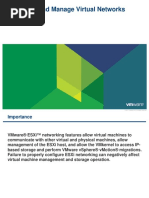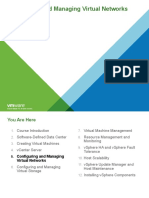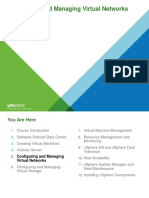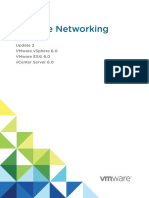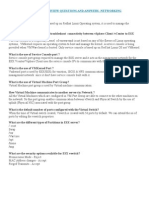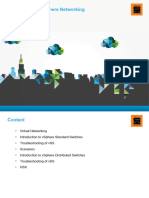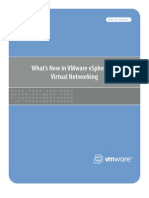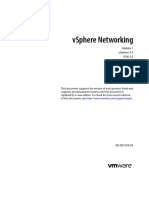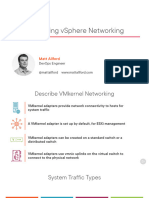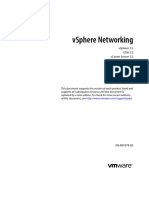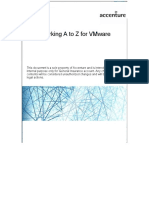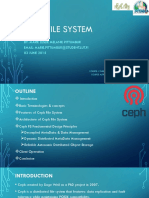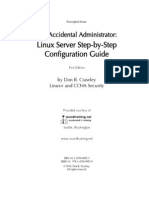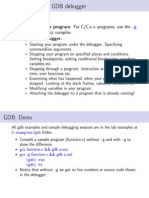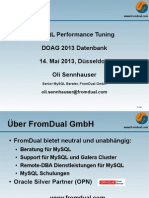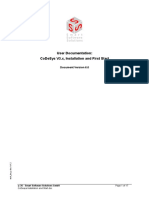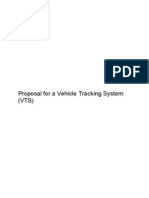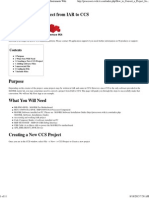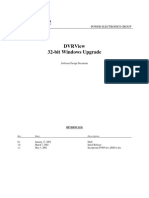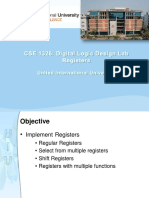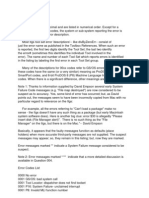Configuring and Managing Virtual Networks
Module 5
2012 VMware Inc. All rights reserved
�You Are Here
Course Introduction
Data Protection
Introduction to Virtualization
Access and Authentication Control
Creating Virtual Machines
Resource Management and Monitoring
VMware vCenter Server
High Availability and Fault Tolerance
Configuring and Managing Virtual Networks
Host Scalability
Configuring and Managing vSphere Storage
Patch Management
Virtual Machine Management
Installing VMware vSphere Components
VMware vSphere: Install, Configure, Manage Revision A
5-2
2012 VMware Inc. All rights reserved
�Importance
VMware vSphere ESXi networking features allow the following:
Virtual machines to communicate with other virtual and physical
machines
Management of the ESXi host
The VMkernel to access IP-based storage and perform VMware
vSphere vMotion migrations
Failure to properly configure ESXi networking can negatively affect
virtual machine management and storage operations.
VMware vSphere: Install, Configure, Manage Revision A
5-3
2012 VMware Inc. All rights reserved
�Module Lessons
Lesson 1:
Introduction to vNetwork Standard Switches
Lesson 2:
Configuring Standard Virtual Switch Policies
VMware vSphere: Install, Configure, Manage Revision A
5-4
2012 VMware Inc. All rights reserved
�Lesson 1:
Introduction to vNetwork Standard
Switches
VMware vSphere: Install, Configure, Manage Revision A
5-5
2012 VMware Inc. All rights reserved
�Learner Objectives
After this lesson, you should be able to do the following:
Define a virtual network.
Describe a virtual switch.
Describe the virtual switch connection types.
Describe the components of a vNetwork standard switch.
Create a vNetwork standard switch.
VMware vSphere: Install, Configure, Manage Revision A
5-6
2012 VMware Inc. All rights reserved
�What Is a Virtual Network? What Is a Virtual Switch?
A virtual network provides networking for hosts and
virtual machines.
A virtual switch:
Directs network traffic
between virtual machines
and links to external
networks.
Combines the bandwidth of
multiple network adapters
and balances traffic among
them. It can also handle
physical network interface card (NIC)
failover.
Models a physical Ethernet switch:
Virtual
NIC
Virtual
NIC
Virtual
NIC
Physical NIC
vmnic0
vmnic1
A virtual machines NIC can connect to a port.
Each uplink adapter uses one port.
VMware vSphere: Install, Configure, Manage Revision A
5-7
2012 VMware Inc. All rights reserved
�Types of Virtual Switch Connections
A virtual switch allows the following connection types:
One or more virtual machine port groups
VMkernel port:
For IP storage, vMotion migration, VMware vSphere Fault Tolerance
For the ESXi management network
Production
Test Dev
VMware vSphere: Install, Configure, Manage Revision A
DMZ
vMotion Management
5-8
2012 VMware Inc. All rights reserved
�Virtual Switch Connection Examples
More than one network can coexist on the same virtual switch, or
networks can exist on separate virtual switches.
VMware vSphere: Install, Configure, Manage Revision A
5-9
2012 VMware Inc. All rights reserved
�Types of Virtual Switches
A virtual network supports two types of virtual switches:
vNetwork standard switches:
Virtual switch configuration for a single host
Discussed in this module
vNetwork distributed switches:
Virtual switches that provide a consistent network configuration for virtual
machines as they migrate across multiple hosts
VMware vSphere: Install, Configure, Manage Revision A
5-10
2012 VMware Inc. All rights reserved
�Standard Virtual Switch Components
VMware vSphere: Install, Configure, Manage Revision A
5-11
2012 VMware Inc. All rights reserved
�Default Standard Virtual Switch Configuration
Display standard
virtual switches.
Enable IPv6 on
ESXi host.
Delete the
virtual switch.
Display virtual
switch properties.
Display Cisco
Discovery Protocol
information.
Display port group
properties.
VMware vSphere: Install, Configure, Manage Revision A
5-12
2012 VMware Inc. All rights reserved
�Standard Virtual Switch Ports
You can change the number of ports on a standard virtual switch.
VMware vSphere: Install, Configure, Manage Revision A
5-13
2012 VMware Inc. All rights reserved
�Network Adapter Properties
For each physical adapter, speed and duplex can be changed.
You might need to set the speed and duplex for certain NIC and
switch combinations.
VMware vSphere: Install, Configure, Manage Revision A
5-14
2012 VMware Inc. All rights reserved
�VLANs
ESXi supports 802.1Q VLAN tagging.
Virtual switch tagging is one of three
tagging policies supported.
Packets from a virtual machine are
tagged as they exit the virtual switch.
Packets are untagged as they return
to the virtual machine.
Affect on performance is minimal.
ESXi provides VLAN support by
giving a port group a VLAN ID.
VMware vSphere: Install, Configure, Manage Revision A
5-15
2012 VMware Inc. All rights reserved
�Physical Network Considerations
Discuss VMware vSphere networking needs with your network
administration team. Discuss the following issues:
Number of physical switches
Network bandwidth required
Physical switch support for 802.3AD (for NIC teaming)
Physical switch support for 802.1Q (for VLAN trunking)
Network port security
Cisco Discovery Protocol (CDP) and its operational modes: listen,
broadcast, listen and broadcast, and disabled.
VMware vSphere: Install, Configure, Manage Revision A
5-16
2012 VMware Inc. All rights reserved
�Lab 5
In this lab, you will create a standard virtual switch and port group.
1. View the current standard virtual switch configuration.
2. Create a standard virtual switch with a virtual machine port group.
3. Attach your virtual machine to a virtual switch port group.
VMware vSphere: Install, Configure, Manage Revision A
5-17
2012 VMware Inc. All rights reserved
�Review of Learner Objectives
You should be able to do the following:
Define a virtual network.
Describe a virtual switch.
Describe the virtual switch connection types.
Describe the components of a vNetwork standard switch.
Create a vNetwork standard switch.
VMware vSphere: Install, Configure, Manage Revision A
5-18
2012 VMware Inc. All rights reserved
�Lesson 2:
Configuring Standard Virtual Switch
Policies
VMware vSphere: Install, Configure, Manage Revision A
5-19
2012 VMware Inc. All rights reserved
�Learner Objectives
After this lesson, you should be able to describe the security
properties of a standard virtual switch port group:
Security
Traffic shaping
NIC teaming policies
VMware vSphere: Install, Configure, Manage Revision A
5-20
2012 VMware Inc. All rights reserved
�Network Policies
Three network policies:
Security
Traffic shaping
NIC teaming
Policies are defined:
At the standard virtual switch level:
Default policies for all the ports on the standard virtual switch
At the port or port group level:
Effective policies: Policies defined at this level override the default policies
set at the standard virtual switch level.
VMware vSphere: Install, Configure, Manage Revision A
5-21
2012 VMware Inc. All rights reserved
�Security Policy
Administrators can configure layer 2 Ethernet security options at the
standard virtual switch and at the port groups.
VMware vSphere: Install, Configure, Manage Revision A
5-22
2012 VMware Inc. All rights reserved
�Traffic-Shaping Policy
Network traffic shaping is a mechanism for controlling a virtual
machines network bandwidth.
Average rate, peak rate, and burst size are configurable.
VMware vSphere: Install, Configure, Manage Revision A
5-23
2012 VMware Inc. All rights reserved
�Configuring Traffic Shaping
Traffic shaping is
disabled by default.
Parameters apply to
each virtual NIC in
the standard virtual
switch.
On a standard
switch, traffic
shaping controls
outbound traffic
only.
VMware vSphere: Install, Configure, Manage Revision A
5-24
2012 VMware Inc. All rights reserved
�NIC Teaming Policy
NIC Teaming
settings:
Load Balancing
(outbound only)
Network Failure
Detection
Notify Switches
Failback
Failover Order
VMware vSphere: Install, Configure, Manage Revision A
5-25
2012 VMware Inc. All rights reserved
�Load-Balancing Method: Originating Virtual Port ID
virtual
switch
virtual
NICs
VMware vSphere: Install, Configure, Manage Revision A
physical
switch
physical
NICs
5-26
2012 VMware Inc. All rights reserved
�Load-Balancing Method: Source MAC Hash
Internet
physical
switch
virtual
switch
virtual
NICs
physical
NICs
VMware vSphere: Install, Configure, Manage Revision A
5-27
2012 VMware Inc. All rights reserved
�Load-Balancing Method: IP-Hash
Internet
physical
switch
virtual
switch
virtual
NICs
physical
NICs
VMware vSphere: Install, Configure, Manage Revision A
5-28
2012 VMware Inc. All rights reserved
�Detecting and Handling Network Failure
Network failure is detected by the
VMkernel, which monitors:
Link state only
Link state, plus beaconing
Switches can be notified whenever:
A failover event occurs
A new virtual NIC is connected to
the virtual switch
Failover implemented by the VMkernel
based on configurable parameters:
Failback:
How physical adapter is returned to active duty after recovering from failure
Load-balancing option:
Use explicit failover order. Always use the highest order uplink from the list
of active adapters that pass failover detection criteria.
VMware vSphere: Install, Configure, Manage Revision A
5-29
2012 VMware Inc. All rights reserved
�Review of Learner Objectives
You should be able to describe the security properties of a standard
virtual switch port group:
Security
Traffic shaping
NIC teaming policies
VMware vSphere: Install, Configure, Manage Revision A
5-30
2012 VMware Inc. All rights reserved
�Key Points
There are two connection types on a virtual switch: virtual machine and
VMkernel.
A standard virtual switch is a virtual switch configuration for a single
host.
Network policies set at the standard virtual switch level can be
overridden at the port group level.
Questions?
VMware vSphere: Install, Configure, Manage Revision A
5-31
2012 VMware Inc. All rights reserved
